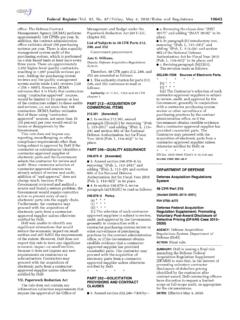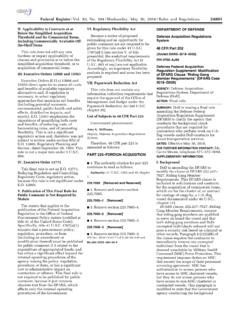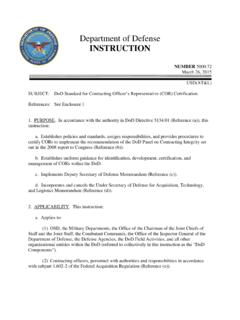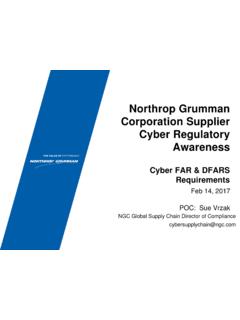Transcription of DFARS Defense Federal Acquisition Regulation …
1 DFARS Defense Federal Acquisition Regulation supplement The Federal Acquisition regulations System is established for the codification and of uniform policies and procedures for Acquisition of all executive agencies. The Acquisition regulations System consists of the Federal Acquisition Regulation (FAR) the primary document, and agency Acquisition regulations that implement or supplement the FAR. The DFARS are the Defense Federal Acquisition regulations supplement , a supplement to the FAR that provides the DoD specific Acquisition regulations . The office of the Under Secretary of Defense for Acquisition Technology and Logistics maintains the Defense Procurement and Acquisition Policy.
2 DFARS , Preference for Domestic Specialty Metals, Alt 1 has the following basic requirements: Specialty metals must be melted in the United States or a qualifying country, or they can be melted anywhere but must be "incorporated in an article manufactured in a qualifying country". The clause allows a qualifying country to manufacture parts from metal that was melted anywhere, provided it meets specifications, but a United States company can only use metal that was melted in the United States or a qualifying country. As of the date of this document, the qualifying countries are Australia, Belgium, Canada, Denmark, Egypt, Germany, France, Greece, Israel, Italy, Luxembourg, Netherlands, Norway, Portugal, Spain, Sweden, Switzerland, Turkey, United Kingdom and Northern Ireland.
3 "Specialty Metals" means: (a) Steel with a maximum alloy content exceeding one or more of the following limits: manganese, , silicon, , or copper, , or containing more than of any of the following elements: aluminum, chromium, cobalt, columbium, molybdenum, nickel, titanium, tungsten, or vanadium. Example 1: Steel containing chromium melted in Japan and used in the United States by the manufacturer of an item to be delivered pursuant to a contract with the US Government is not compliant with Alt I. Explanation: Steel containing more than .25% chromium is defined as a specialty metal and, therefore, must either be melted in the United States or a qualifying country, or be melted anywhere and incorporated into a deliverable item in a qualifying country.
4 Japan is not on the list of qualifying countries. Example 2: Steel melted in Mexico containing .20% chromium and not having alloy or element contents in excess of the thresholds set forth in DFARS , Alt I is compliant with the DFARS clause. Explanation: Steel containing more than .25% chromium is defined as a specialty metal. The steel described in Example 2 is not a "specialty metal" and therefore does not have to be produced in the United States or a qualifying country. This material from Mexico would be acceptable. Note that Mexico is not on the list of Qualifying Countries, however, the material does not meet the definition of "Specialty Metal". (b) Metal alloys consisting of nickel, iron-nickel, and cobalt base alloys containing a total of other alloying metals (except iron) in excess of 10 percent; Example: All Samarium Cobalt magnets are considered "Specialty Metals" because its cobalt content is over 10% and therefore may not be supplied to the US Government on contracts that impose this clause.
5 Alnico magnets are also considered "Speciality Metals" because it consists of nickel and again fall under the same provisions as described. (c) Titanium and titanium alloys; and (d) Zirconium and zirconium base alloys.




